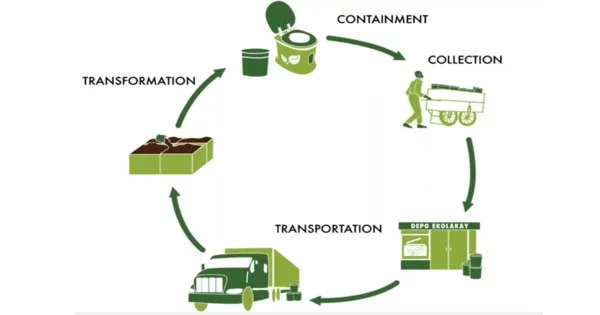Ecological sanitation is a method of sanitation that tries to safely reuse excreta in agriculture. It is a concept, rather than a technique or a device, that is defined by a goal to “close the loop,” primarily for nutrients and organic matter, between sanitation and agriculture in a safe manner. It strives to reduce the environmental impact of sanitation systems while simultaneously promoting the safe and effective reuse of human waste as a resource.
One of the goals is to reduce the usage of nonrenewable resources. When correctly constructed and managed, ecosan systems provide a hygienically safe system for converting human excreta into nutrients that can be returned to the soil and water that can be returned to the land. Ecosan is also called resource-oriented sanitation.
Key principles and components of ecological sanitation include:
- Source Separation: Ecosan systems segregate human waste at the source, which means that urine and feces are collected independently from one another as well as from other wastewater streams (for example, graywater). This separation helps to preserve the waste streams’ quality and nutritional content for eventual reuse.
- Nutrient Recycling: The safe recycling of nutrients contained in human waste, notably nitrogen and phosphorus, is a basic principle of ecological sanitation. These nutrients can be utilized to improve soil and enhance long-term agriculture. Composting and urine diversion are two prominent methods for accomplishing this.
- Water Conservation: Ecosan systems promote water saving by using the least amount of water possible for flushing and sanitation procedures. To save water, dry toilets and low-flush toilets are frequently used.
- Treatment and Disinfection: To ensure the safe reuse of human waste, ecological sanitation systems include treatment and disinfection processes to kill pathogens and reduce health risks. This may involve composting, solar drying, or other techniques.
- Environmental Impact Reduction: Ecosan systems aim to minimize the environmental impact of sanitation by reducing the pollution of water bodies and soil. By separating waste and treating it appropriately, these systems can prevent contamination of natural ecosystems.
- Community Engagement: Successful implementation of ecological sanitation often requires community involvement and education. Communities must understand the benefits of ecosan systems and be actively involved in their design, construction, and maintenance.
- Adaptability: Ecological sanitation can be adapted to various settings, including urban and rural areas, and can be implemented at various scales, from individual households to entire communities.
EcoSan is especially useful in locations where typical centralized wastewater treatment systems are impractical due to issues such as water shortages, a lack of infrastructure, or the high expense of standard sanitation methods. It provides a long-term solution to sanitation issues while simultaneously improving soil fertility and lowering pollution.
Composting toilets, urine-diverting dry toilets (UDDTs), and built wetlands for wastewater treatment are examples of ecosan technology. Ecological sanitation offers a comprehensive and environmentally friendly approach to sanitation that is consistent with the ideals of sustainable development and resource conservation.
















